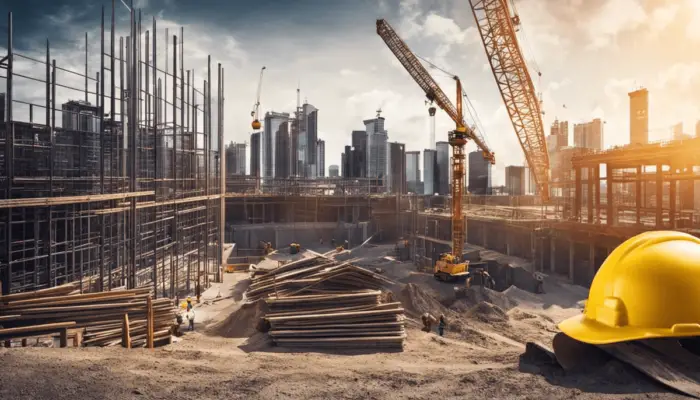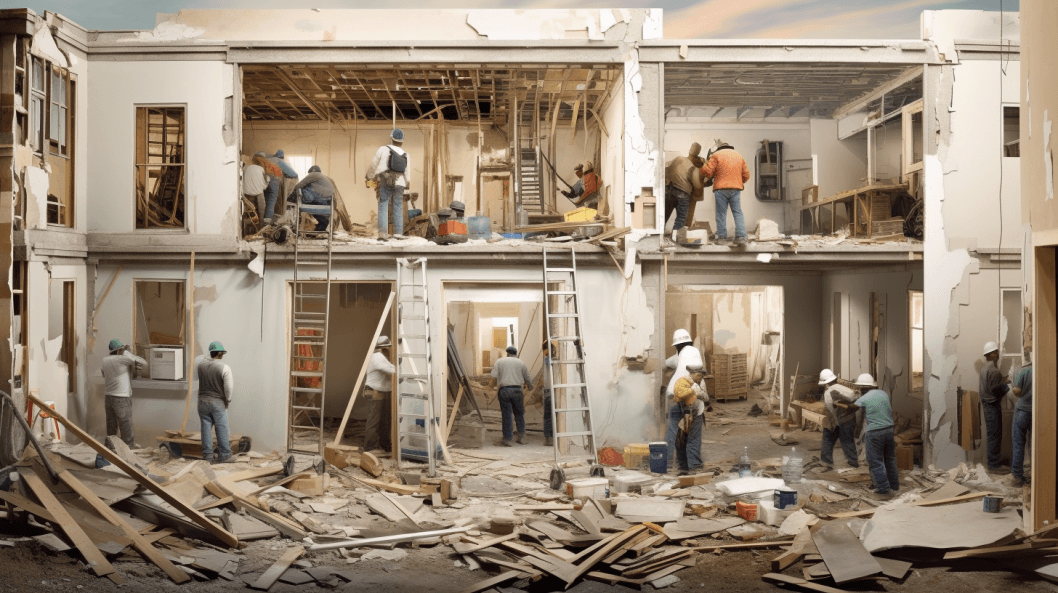A considerable amount of risk is attached to the scope of construction and renovation projects. While building a property, you’re vulnerable to unfortunate events which could stall your project, resulting in an escalating budget.
A specialized form of coverage, known as Builders Risk Insurance, exists to provide a financial safety net in such circumstances.
This article deepens the understanding of Builders Risk Insurance, contrasting it with regular homeowner’s insurance and emphasizing its essential role during renovations.
It provides a step-by-step guide to sourcing the right policy and demystifies misconceptions surrounding this vital insurance instrument.
Basics of Builders Risk Insurance
What is Builders Risk Insurance?
Builders’ risk insurance is a specialized type of property insurance that protects construction projects against damage while they’re underway. This could include the construction of new buildings or the renovation of existing structures.
The projects are typically covered for risks like theft, fire, vandalism, and certain weather-related damage during construction or renovation. The policy normally covers the work site and temporary constructions like scaffolding, materials, and equipment.
Builders Risk Insurance for Renovations
When undertaking renovations, builders’ risk insurance is crucial as it protects the value of your work against the same risks for a new construction project.
If, for instance, you’re adding a new room to a building and it gets destroyed by a fire before the renovation is complete, your normal property insurance may not cover this kind of loss. Builders’ risk insurance steps in where your traditional property insurance might not.
Therefore, if you’re a property owner or a contractor involved in a renovation project, you should consider purchasing builders’ risk insurance.
How it Works
Builders risk insurance works by paying for damages up to the coverage limit. The policyholder must determine the limit, often based on the estimated total cost of construction or renovation. The policy does not cover damages beyond the maximum coverage amount defined in the policy.
Factors that typically influence the cost of builders‘ risk insurance cost include project value, construction type, location, and duration.
However, it’s crucial to understand what your policy does not include. It often excludes certain damages, such as faulty design, planning, workmanship, and materials or damage from earthquakes, flooding, and acts of war. To cover these exclusions, you would need to procure additional insurance.
Who Benefits from Builders Risk Insurance?
Builders’ risk insurance benefits anyone financially interested in the construction or renovation project. This could be the property owner, general contractor, subcontractors, or in some cases, the architect or engineer.
The property owner or contractor commonly takes out these policies. However, all parties involved need to be sure they understand the scope of the coverage and how it impacts their individual risks and responsibilities.
Why it’s Important
Considering the diverse risks at a construction or renovation site, having builders’ risk insurance can protect from significant financial loss.
Insurance plays an integral role in mitigating these risks, from an unexpected event like a fire or theft to certain weather damages, translating to substantial costs. It’s therefore considered a sound investment towards safeguarding interests in a project.
Sufficient insurance can mean the difference between the smooth completion of a project and costly delays or even total loss.
When to Consider Builders Risk Insurance
Whenever construction or renovations are happening, it’s a prudent step to consider builders’ risk insurance. Especially for large and costly projects where potential loss from damages could be significant.
From the moment construction materials arrive on site, the construction or renovation process exposes the project to a host of potential damages. Hence, starting the policy as soon as possible can maximize its benefits.
Final Thoughts
Not only for large-scale construction endeavours, but builders’ risk insurance is also invaluable for individuals undertaking smaller renovation projects.
By understanding and efficiently managing the associated risks, you can mitigate expensive setbacks and guarantee your project reaches completion successfully.

The Necessity of Builders Risk Insurance during Renovations
Delving into the Details of Builders Risk Insurance
Builders’ Risk Insurance is a particular kind of property insurance designed to safeguard construction sites from potential threats such as theft, fire, vandalism, and severe weather events.
More often than not, construction contracts require this type of insurance to protect the vested interests of property owners, contractors, and lenders.
This insurance is crucial not only for new construction projects but also plays a key role in the renovation and remodeling of existing structures.
Significance of Builders Risk Insurance during Renovations
Unlike standard homeowner’s policies, builders’ risk insurance covers construction periods when risks are arguably heightened.
This insurance is especially necessary during renovations, given the increased likelihood of specific risks. For instance, renovation often involves stripping walls or removing foundational supports, making the structure more vulnerable to accidental damage or collapse.
Coverage and Limitations
The Insurance covers the structure itself and, in many cases, the materials on site waiting to be installed or transported to the job site.
It also protects against liability claims and potential medical costs if anyone gets injured on the site. However, it does not cover accidents and injuries at work or poor workmanship; contractors’ general liability insurance usually covers these.
Risk Transfer to Insurer
With a builder’s risk insurance, the financial risk associated with damages during construction gets transferred from the property owner or contractor to the insurance company.
Since renovations could easily run into tens or even hundreds of thousands of dollars, this insurance protects one’s financial interest by ensuring the insurer bears the brunt of any loss.
Responsibility of Purchasing Builders Risk Insurance
While it may seem logical for the contractor to take out the policy, it’s often beneficial for the property owner to buy it.
This gives them more control over the limits and terms of coverage and allows them to select a policy that best fits their unique needs. However, whether the owner or contractor buys the policy, both parties should be named insureds.
Scenario without Builders Risk Insurance
The project might face substantial financial losses when a renovation is in progress without builder risk insurance. Suppose a severe storm demolishes the property mid-renovation, or thieves steal essential building materials.
Without adequate coverage, the property owner or contractor would have to foot these losses, leading to potentially severe financial strain. Thus, builder’s risk insurance offers invaluable financial protection during renovation.
Final Consideration
The need for Builder’s Risk Insurance during renovations greatly depends on the scale and complexity of the renovation project. This insurance becomes vital for major structural modifications or extensive renovation efforts.
Further, if the property involved is under the mortgage and the planned renovations are substantial, the provider may require it. Unanticipated occurrences arise, and the absence of such insurance could lead to severe financial consequences.

Comparing Builders Risk Insurance to Standard Homeowner’s Insurance
Understanding Builders Risk Insurance versus Standard Homeowner’s Insurance
Builder’s risk insurance, alternately called course of construction insurance, is a branch of property insurance. It offers coverage for a property undergoing construction or substantial renovations and is commonly sourced by contractors or renovators.
Conversely, standard homeowner’s insurance is another type of property insurance that covers non-commercial residential properties and their associated belongings.
Contrast Between Builders Risk Insurance and Standard Homeowner’s Insurance
While both insurances safeguard properties, differences lie in coverage, triggering events, and timing. Builders’ risk insurance is purchased to account for risks associated with a construction project.
It covers damages to the structure, materials, and fixtures during construction or renovation. Its coverage extends to perils like theft, fire, vandalism, and certain weather-related damages, but it does not cover accidents, liability, or equipment breakdowns.
Such is not the case with standard homeowner’s insurance, which is renewed annually and covers only minor renovations and broad property liability protection.
Furthermore, it has predetermined coverage on theft, loss of use, personal liabilities, and medical payments to others.
The necessity of Builders Risk Insurance Over Standard Homeowner’s Insurance
Standard homeowner’s insurance isn’t designed to cope with the risks involved in significant remodelling projects. While renovations to your home may increase home value, those alterations can raise accidents or damage risks.
If you’re renovating your home and you plan to stay in it throughout the process, a standard homeowner’s policy may leave you underinsured.
For this reason, builders’ risk insurance is particularly useful. In many scenarios where considerable structural changes are being made, homeowner’s insurance may simply not suffice.
Builders’ risk insurance fills in the coverage gaps left by the homeowner’s insurance before renovation completion when the standard homeowner’s policy fully applies again.
Navigating the Insurance Maze for Renovations
When it comes to insurance needs during a renovation, many factors come into play – the level of security required, the scale of the renovation, and the norms of the insurance providers.
A homeowner’s insurance might be sufficient for relatively small upgrades such as revamping a kitchen or adding a new bathroom. However, builders’ risk insurance becomes indispensable when it comes to larger, more complex renovations like room extensions or building new structures.
As an industry professional, it’s important to understand that builders’ risk insurance complements homeowner’s insurance; it’s not a substitute.
Adequately assessing policy details and weighing the cost against benefits is essential. The recommended approach is to engage a trusted insurance agent before starting any renovation. They hold the expertise to guide you effectively about your insurance and liability requirements during the renovation.

Selecting and Buying the Right Builders Risk Insurance
Diving Deeper Into Builders Risk Insurance
Broadly spoken, builders’ risk insurance is a unique form of property insurance designated for buildings that are either under construction or being renovated.
Usually, it safeguards materials, fixtures, and equipment incorporated in the construction or renovation work. It typically provides coverage against a wide array of risks – from physical damages arising out of theft, vandalism, and fire to natural disasters.
Why You Need Builders Risk Insurance for Renovations
When undertaking a renovation project, there are several risks involved. A fire could break out, damaging the new construction and existing structures.
Storms could cause water damage or completely halt work. Materials and equipment could be stolen from the job site. All of these incidents could result in financial losses. A builder’s risk insurance helps cover these risks, protecting the policy owner’s financial investment in the renovation project.
Choosing the Right Builders Risk Insurance Policy
When selecting a builders risk insurance policy, it’s important to assess your renovation project’s specific needs and risks. Consider the scope and size of the project, as well as its location.
A policy should offer enough coverage to replace lost or damaged materials and pay for necessary repairs should an incident occur.
Pay close attention to policy exclusions. Many policies exclude events like earthquakes and floods. If your renovation project is in an area prone to these types of natural disasters, you may need to purchase additional coverage.
Working With Insurance Agents or Brokers
Insurance agents or brokers can be invaluable when buying builders’ risk insurance. They can help you understand policy terms and conditions, identify any coverage gaps, and find a policy that fits your budget and meets your coverage needs.
When working with an agent or broker, provide accurate and detailed information about your renovation project to ensure they can find you the most appropriate coverage.
Determining How Much Coverage You Should Buy
The amount of coverage you should buy depends on several factors, including the total cost of your renovation project, the value of the property being renovated, and the potential risks involved.
As a general rule, your coverage limit should be enough to cover the total completed value of the project, including both material and labour costs.
It’s recommended to regularly review and adjust your coverage as your renovation project progresses. You may need to increase your coverage limit as you move further along in the construction process and the value of the work increases.
Managing the Claims Process
You must furnish your insurance company with evidence of the damage when a loss occurs. This may encompass taking photographs, retaining receipts for items that have been lost or damaged, and acquiring quotes for necessary repair work.
Maintaining comprehensive records of all expenditures and materials related to your project; will be indispensable in ensuring that you receive an equitable settlement if a claim becomes necessary.

Common Misconceptions and FAQs about Builders Risk Insurance
Insight into Builders Risk Insurance
Builders ‘ risk insurance is a type of insurance aimed specifically at properties in the construction or major renovation phase. It’s also commonly referred to as a course of construction insurance.
This distinct form of coverage typically extends to damage caused by numerous events such as fire, wind, theft, and vandalism. Additional protections might extend to temporary structures, scaffolding, and debris removal.
It’s usual for the property owner or the contractor to secure this insurance policy, which is often stipulated by financial institutions when allocating construction loans.
Nevertheless, it’s critical to remember that the coverage duration of builders’ risk insurance is limited, and it ends once the construction or renovation project is officially completed.
Misconception: Builders Risk Insurance Is Not Necessary for Renovations
One common myth pertains to the necessity of builders’ risk insurance during renovations. Some believe they do not need additional coverage since they already have homeowners or commercial property insurance. However, this assumption can leave property owners and contractors seriously exposed to risk.
Many standard property insurance policies have limitations or exclusions for properties under construction or significant renovation.
Specifically, these policies may not cover damages brought about by construction-related events, such as poor workmanship, design flaws, or materials deficiencies. Thus, obtaining builders‘ risk insurance is pivotal for renovations regardless of existing coverage.
Misconception: All Risks Are Covered Under Builders Risk Insurance
Another common misconception is that builders’ risk insurance provides blanket coverage against all possible risks. This is not true, as each policy has its specific terms, conditions, and exclusions. For instance, common exclusions could include normal wear and tear, underground damage or damages due to faulty design or materials.
Depending on the policy, certain risks like floods and earthquakes might also be excluded unless specifically included. Hence, it is critical to thoroughly understand the terms of your builder’s risk insurance policy and consider incorporating additional policies or endorsements to fill any potential coverage gaps.
FAQ: Who Needs Builders Risk Insurance?
Building owners and construction contractors primarily require builders’ risk insurance. However, anyone interested in the construction or renovation project might consider getting it. This includes property developers, architects and engineers, and lending institutions.
What Does Builders Risk Insurance Cover?
Builders’ risk insurance generally covers damage to the building under construction or renovation from various perils, such as fire, wind, theft, and vandalism. It can also include coverage for soft costs like loan interest or loss of income due to project delays caused by covered losses.
Does Builders Risk Insurance Cover Theft and Vandalism?
Yes, builders’ risk insurance typically covers theft and vandalism, but it may be subject to certain conditions or caps. For instance, theft of unsecured materials or in an unattended job site may not be covered.
How Much Do Builders Risk Insurance Cost?
The cost of builders’ risk insurance can vary depending on factors such as the project value, the type of construction or renovation, the site’s location, and the policy’s scope and limits. Industry averages typically range from 1% to 4% of the total construction budget.
In conclusion, builders’ risk insurance is crucial in mitigating risks associated with construction or renovation projects. Understanding common misconceptions and getting answers to frequently asked questions can help you choose the right coverage for your specific needs.

Conclusion
Establishing clarity about builder’s risk insurance is an asset for any industry expert, homeowner or contractor. It’s another add-on and a strategic decision to protect one’s investment and future.
Through scrutinizing the basics, analyzing its importance, distinguishing it from standard insurance, and figuring out the right way to purchase it, one can be assured of its essence during renovations.
Furthermore, clearing common misconceptions and answering FAQs enhances understanding and eliminates ambiguities. It can be surmised, therefore, that an investment in builders’ risk insurance is a cornerstone to secure renovation projects from unforeseeable damages and losses.

Chris Ekai is a Risk Management expert with over 10 years of experience in the field. He has a Master’s(MSc) degree in Risk Management from University of Portsmouth and is a CPA and Finance professional. He currently works as a Content Manager at Risk Publishing, writing about Enterprise Risk Management, Business Continuity Management and Project Management.

